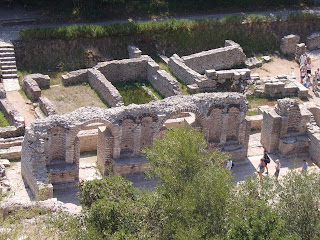 |
| Butrint - Albania |
Brief Report
since prehistoric times, Butrint is the site of a Greek colony, a Roman city, and a bishopric. After a period of prosperity under Byzantine governance, then a short occupation by the Venetians the city was abandoned in the late Middle Ages after marshes formed in the area. The current archaeological site is a collection of ruins of each period in the city develops.
Wide Report
The city of Butrint is one of the fragments which the structure of Albania the old cultural landscape. Tucked away in the highlands in the extreme south of the country and is surrounded by dense vegetation, Butrint was linked to the Mediterranean Sea by the Vivari canal, which runs from the Butrint More of the Ionian Sea.
The settlement was an important stop along the merchant trade routes and reached the height of her fame in the 4th century BC one of the most important maritime and commercial centers of the ancient world. The sight of the fortifications, which date back to the 6th century BC, calls on the military and economic potential of the city. The hill of the acropolis is surrounded by a wall of huge stone blocks. The amphitheatre, dating back to the 3rd century BC, is testimony to the cultural richness of the city: the stone benches chairs, of which 23 rows are preserved, would have held an audience of 1500. The theater is located at the foot of the acropolis. Near two temples, one of which is devoted to Asclepios, Greek god of medicine, who was worshipped by the inhabitants.
Excavations have the light of many objects - plates, vases, ceramic candlesticks - as well as sculptures including a remarkable 'Goddess of Butrint' which appears to be fully embody, in the perfection of its functions, the Greek ideal of physical beauty. Under the rule of the Romans was the city slowly falls into decline. Despite this, three monumental fountains, three public baths, a gymnasium decorated with mosaics and especially the aqueduct built during the reign of August, demonstrate that the site is not yet fully abandoned.
In the palaeo-Christian period, two basilicas and a baptistry were built; his later medieval history was stormy the city was involved, in the first place the power struggle between Byzantium and successive Norman, a better starting point and Venetian states and then in the conflict between Venice and the Ottoman Turks. Underground infiltration of water forced the inhabitants forced to flee, and the abandoned city was covered with mud and vegetation. It was not until the beginning of the 20th century systematic excavations were carried out by Italian archaeologists; after the liberation of Albania in 1944, Albanian archaeologists more ambitious excavations. The mud and the vegetation that Butrint have protected the natural and human stood, and the whole town was found almost intact.
Important areas of digging a late antique palatial home known as the Triconch Palace, the spectacular late antiquity baptistery and a Roman villa and the corresponding late antiquity Diaporit church.
Historical Data
The location on a hill next to a more connected to the sea by a canal has been inhabited since prehistoric times. A Greek colony was founded in the late 7th century BC. When the city (the so-called Buthros) was surrounded by fortifications. Roman occupation is prompted the development of the city. During the Christian era. It was the seat of a diocese. Many religious structures were built by the Christians. From the moment that the Slaves arrived in the Balkans (7th century) to the creation of the Epirus despotate (after the intake of Constantinople by the crusaders in 1204). The city underwent major tests. The last era of prosperity was under Byzantine governance (Epirus). After a short period of occupation by the Venetians (late 14th century). The city under Ottoman administration was threatened by the marshes which formed around the lake. And it was by the population.
This archaeological site is a real conservatory of important monuments in ruins from each period of the development. So. The fortifications is testimony to the various stages of the construction from the time of the Greek colony of the Middle Ages. The most interesting ancient Greek monument is the theater. Which is pretty well preserved. The large ruin of the palaeo-Christian era is the baptistry. Built into the Roman public baths. The floor is a beautiful mosaic decoration. The palaeo-Christian basilica was rebuilt in the 9th century and the ruins are so well preserved that analysis of the structure (three naves with a transept. And an outer polygonal between apse).

No comments:
Post a Comment